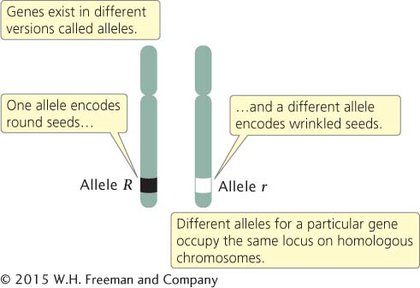Genetic Terminology
Before we examine Mendel’s crosses and the conclusions that he drew from them, a review of some terms commonly used in genetics will be helpful (Table 3.1). The term gene is a word that Mendel never knew. It was not coined until 1909, when Danish geneticist Wilhelm Johannsen first used it. The definition of a gene varies with the context of its use, so its definition will change as we explore different aspects of heredity. For our present use in the context of genetic crosses, we will define a gene as an inherited factor that determines a characteristic.
| Term | Definition |
|---|---|
| Gene | An inherited factor (region of DNA) that helps determine a characteristic |
| Allele | One of two or more alternative forms of a gene |
| Locus | Specific place on a chromosome occupied by an allele |
| Genotype | Set of alleles possessed by an individual organism |
| Heterozygote | An individual organism possessing two different alleles at a locus |
| Homozygote | An individual organism possessing two of the same alleles at a locus |
| Phenotype | The appearance or manifestation of a or characteristic |
| Characteristic or character | An attribute or feature possessed by and organism |
Genes frequently come in different versions called alleles (Figure 3.2). In Mendel’s crosses, seed shape was determined by a gene that exists as two different alleles: one allele encodes round seeds and the other encodes wrinkled seeds. All alleles for any particular gene will be found at a specific place on a chromosome called the locus for that gene. (The plural of locus is loci; it’s bad form in genetics—

The genotype is the set of alleles that an individual organism possesses. A diploid organism with a genotype consisting of two identical alleles is homozygous for that locus. One that has a genotype consisting of two different alleles is heterozygous for the locus.
Another important term is phenotype, which is the manifestation or appearance of a characteristic. A phenotype can be any type of characteristic—
A given phenotype arises from a genotype that develops within a particular environment. The genotype determines the potential for development: it sets certain limits, or boundaries, on that development. How the phenotype develops within those limits is determined by the effects of other genes and of environmental factors, and the balance between these effects varies from characteristic to characteristic. For some characteristics, the differences between phenotypes are determined largely by differences in genotype. In Mendel’s peas, for example, the genotype, not the environment, largely determined the shape of the seeds. For other characteristics, environmental differences are more important. The height reached by an oak tree at maturity is a phenotype that is strongly influenced by environmental factors, such as the availability of water, sunlight, and nutrients. Nevertheless, the tree’s genotype still imposes some limits on its height: an oak tree will never grow to be 300 meters (almost 1000 feet) tall, no matter how much sunlight, water, and fertilizer are provided. Thus, even the height of an oak tree is determined to some degree by genes. For many characteristics, both genes and environment are important in determining phenotypic differences.
An obvious but important point is that only the alleles of the genotype are inherited. Although the phenotype is determined, at least to some extent, by genotype, organisms do not transmit their phenotypes to the next generation. The distinction between genotype and phenotype is one of the most important principles of modern genetics. The next section describes Mendel’s careful observations of phenotypes through several generations of breeding experiments. These experiments allowed him to deduce not only the genotypes of individual pea plants, but also the rules governing their inheritance.
CONCEPTS
Each phenotype results from a genotype developing within a specific environment. The alleles of the genotype, not the phenotype, are inherited.
 CONCEPT CHECK 2
CONCEPT CHECK 2
What is the difference between a locus and an allele? What is the difference between genotype and phenotype?
A locus is a place on a chromosome where genetic information encoding a characteristic is located. An allele is a version of a gene that encodes a specific trait. A genotype is the set of alleles possessed by an individual organism, and a phenotype is the manifestation or appearance of a characteristic.